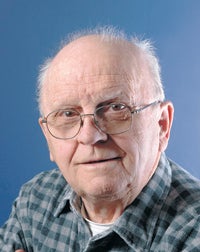City Beach used to be the main swimming spot
Published 9:17 am Friday, September 3, 2010
Ed Shannon, Between the Corn Rows
During this year’s “Echoes From the Past: A Journey Into History” program at Graceland Cemetery on the evening of Aug. 18, Roger Wessels did a fine job of portraying the role of local contractor John P. Larson (1887-1972).
As I listened to Roger’s part of the program, there was a feeling that the John Larson he was portraying also had an interesting connection with the municipal beach at the west end of Johnson Street.
I did a little research and found out four of my columns in 2004 were based on the early history of Albert Lea’s beach on Fountain Lake. Nearly all the material in those columns was based on a nine-page letter from Robert George “Bob” Larson of Springfield, Ill. He was John’s son and grew up near this lakeside beach. Bob Larson, incidentally, died on June 16, 2007.
I have no intention to repeat those four columns. However, there are some highlights — worth reviving for the reminiscing value — about the place that was once a popular part of local summertime life for several decades.
The Larson connection with this part of the city came in 1928 when Bob’s father, John Larson, purchased the property at 212 W. Johnson St. This property, about where the present City Beach parking lot is located, became the Larson home until about 1942.
During those years the beach was gradually improved. One detail Bob mentioned was the diving tower. This offshore facility had two springboards. One was eight feet above the water and the second was four-feet higher. Photos of this raft-like structure have been featured in the Tribune several times.
In 1937 Bob became the beach custodian during the summer and was paid $125 a month by the city’s Parks Department. He also served as an assistant lifeguard. In his letter. Bob stressed that the beach had certified Red Cross lifeguards.
In part because the Larson family lived so close to the beach, Bob’s mother and two sisters eventually operated the combination of bathhouse and concession stand.
The small, city-owned building was open from June through August. Operating hours were 8 a.m. to 10 p.m. daily. There was a men’s section on the north end of the building and a women’s section on the south end. Each side served as dressing rooms. In the middle of this main building was an area where clothing and valuables could be kept in marked baskets, plus a place where soft drinks and frozen treats were available for purchase.
For years the City Beach was a very popular summertime place, especially on really hot days. Bob mentioned swimming classes, water carnivals, speed boat races (further out in the lake), diving contests, tennis games on the nearby courts, plenty of sunbathing and family picnics in this park-like location.
In the early 1940s the Larson property was purchased by the city. In his letter, Bob mentioned that part of this property was used for the tennis courts. These courts were converted into the present skateboard park in 2001 that was so strongly promoted by Stan Sevaldson, the city’s former postmaster, who died on Dec. 31, 2002.
The most obvious change for what’s still listed as a city park at the corner of Johnson Street and North Shore Avenue came with the opening of the city’s outdoor “cement pond” near the corner of Frank and James avenues in 1977. (That cement pond label is based on the Beverly Hillbillies television program.) Also, there are now indoor swimming pools at the high school, Family Y and several motels.
At the present time Albert Lea’s City Beach area is a nice place for playing volleyball, skateboarding, sunbathing, picnicking, wading into the edge of the lake and just relaxing. However, there are no longer lifeguards on duty, and swimming in the lake isn’t recommended. Besides, the water at the city’s cement pond and those indoor swimming pools has more clarity and purity. After all, who wants to swim in greenish water?
Ed Shannon’s column has been appearing in the Tribune every Friday since December 1984.


